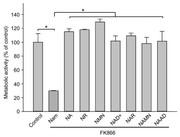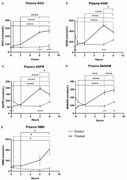NAD+ ⇒ NAD+ Too Big to Enter Cell?
-
ProudDaddy
- Posts: 5
- Joined: Thu Sep 19, 2019 7:51 am
NAD+ Too Big to Enter Cell?
I just read a Facebook post by David Sinclair stating that NAD+ is too large to pass through a cell's membrane and thus only smaller precursors are effective. I thought that there was plenty of evidence that endogenous NAD+ enters the cell. What's true?
Re: NAD+ Too Big to Enter Cell?
It depends on the cell type but this is mostly true, however getting NAD+ or NMN to the tissues intact is the main thing. In the intestines, NMN is transported directly into cells via an enzyme transporter called Slc12a8. In other cell types, when NAD+ or NMN arrives at the tissue it must be first broken down into NR where it can then easily pass through the cell membrane before being upconverted back into NMN and then NAD+. If you could copy/paste his Facebook post here, it would be easier to figure out exactly what he meant but just because NAD+ cannot directly pass through the cell membrane doesn't mean it is not useful. It just has to go through a few steps before being reconstituted in the cell as NAD+.ProudDaddy wrote: ↑Fri Feb 14, 2020 8:16 am I just read a Facebook post by David Sinclair stating that NAD+ is too large to pass through a cell's membrane and thus only smaller precursors are effective. I thought that there was plenty of evidence that endogenous NAD+ enters the cell. What's true?
Re: NAD+ Too Big to Enter Cell?
Jocko thanks for the breakdown.
Re: NAD+ Too Big to Enter Cell?
Thanks Jocko.
By taking both NMN and NAD+, hopefully both bases are being covered. The passive or non stimulating feeling when taking NAD+ as opposed to NMN might be because of the different absorption pathways...
By taking both NMN and NAD+, hopefully both bases are being covered. The passive or non stimulating feeling when taking NAD+ as opposed to NMN might be because of the different absorption pathways...
- ALIVEBYNATURE
- Posts: 65
- Joined: Sat Sep 21, 2019 10:33 am
Re: NAD+ Too Big to Enter Cell?
As Jocko says, research has shown that NAD+ crosses the cell membrane intact in some types of cells.
Other cells types, NMN and NAD+ must be converted to NR (by losing the phospate) to cross the cell membrane.
That makes it sound like a problem, but it does not impede NMN entry into cells at all.
Ecto-enzymes on the outside of cell membranes perform this conversion.
It is sort of like, you live in alaska. A visitor arrives at your house wearing a coat (the phosphate). You require visitors to remove their coat, so they take it off at the front door. It is not a barrier to entry.
On the other hand, NR doesnt have this "coat", so might enter more quickly. Except they often freeze to death in the cold - much like NR is rapidly degraded to NAM in the bloodstream - NR is not stable in blood, while NMN is.
In fact, research published late 2019 show that even in those cells that NMN must lose the phospate to enter, it was MORE EFFECTIVE THAN NR at restoring NAD+ inside the cell (image below).
Placing NR, NMN, and NAD outside of cells, NMN was most effective. Likely because some of the NR was degraded before it could enter the cells.
That is in vitro. In the body, NR is never found in the bloodstream at more than trace levels anyways.
An article on this subject is here.

Other cells types, NMN and NAD+ must be converted to NR (by losing the phospate) to cross the cell membrane.
That makes it sound like a problem, but it does not impede NMN entry into cells at all.
Ecto-enzymes on the outside of cell membranes perform this conversion.
It is sort of like, you live in alaska. A visitor arrives at your house wearing a coat (the phosphate). You require visitors to remove their coat, so they take it off at the front door. It is not a barrier to entry.
On the other hand, NR doesnt have this "coat", so might enter more quickly. Except they often freeze to death in the cold - much like NR is rapidly degraded to NAM in the bloodstream - NR is not stable in blood, while NMN is.
In fact, research published late 2019 show that even in those cells that NMN must lose the phospate to enter, it was MORE EFFECTIVE THAN NR at restoring NAD+ inside the cell (image below).
Placing NR, NMN, and NAD outside of cells, NMN was most effective. Likely because some of the NR was degraded before it could enter the cells.
That is in vitro. In the body, NR is never found in the bloodstream at more than trace levels anyways.
An article on this subject is here.

-
ProudDaddy
- Posts: 5
- Joined: Thu Sep 19, 2019 7:51 am
Re: NAD+ Too Big to Enter Cell?
So, Alive By Nature needs to close down its NAD IV Clinic as a fraud and stop selling sublingual and intranasal NAD+ for the same reason?!?!
- ALIVEBYNATURE
- Posts: 65
- Joined: Sat Sep 21, 2019 10:33 am
Re: NAD+ Too Big to Enter Cell?
I don't understand you point.ProudDaddy wrote: ↑Sun Feb 16, 2020 7:18 am So, Alive By Nature needs to close down its NAD IV Clinic as a fraud and stop selling sublingual and intranasal NAD+ for the same reason?!?!
In some cells, it is able to enter intact thru the cx43 channel. In others, such as hypothalamus, it is shown to enter intact very quickly, but the pathway isn't known.
Some reading with many research studies showing this:
https://alivebynature.com/how-nad-boost ... nd-ageing/
https://alivebynature.com/nad-not-nr-is ... oodstream/
https://alivebynature.com/exogenous-nad ... penditure/
https://alivebynature.com/exogenous-nad ... d-glucose/
The chart below shows that even in cells where it must be converted to NR first, NAD+ is most definately able to enter cells and restore the internal NAD+ levels. There is no doubt at all.
The chart shows it was very slightly less effective than NR and NMN at doing so.
This was from placing the ingredients in plasma outside of cells and checking how effective they were at restoring cells internal NAD+
The chart shows NAM,NMN, NR, and NAD+ are all effective at entering a cell to restore NAD+. But NAM inhibits sirtuins. NR is unstable and never found in blood at more than trace levels.
In the body, it will be far more effective to place NMN or NAD+ in the blood than NR, which is rapidly broken down to NAM.
NAD+ is far more stable and ubititous in the bloodstream, and has no trouble crossing the cell membrane to restore internal NAD+, so providing it direct to the bloodstream via IV or sublingual is very effective.

-
ProudDaddy
- Posts: 5
- Joined: Thu Sep 19, 2019 7:51 am
Re: NAD+ Too Big to Enter Cell?
Sinclair said that since NAD is too large to pass through a cell membrane, only precursors like NR and NMN are efficacious. All the responses to my post said that this is true except maybe in a very small number of tissue types. I can only conclude that increasing exogenous NAD would be futile for most tissue types. So why do it?
My point is that Sinclair may be wrong. I often suspect that his research objective is to find an improved version of NMN that he can patent. Why aren't any of his trials registered on clinicaltrials.gov? Why isn't he looking into different ingestion methods to improve bioavailability. Why does he say NAD can't pass through any cell's membrane?
My point is that Sinclair may be wrong. I often suspect that his research objective is to find an improved version of NMN that he can patent. Why aren't any of his trials registered on clinicaltrials.gov? Why isn't he looking into different ingestion methods to improve bioavailability. Why does he say NAD can't pass through any cell's membrane?
- ALIVEBYNATURE
- Posts: 65
- Joined: Sat Sep 21, 2019 10:33 am
Re: NAD+ Too Big to Enter Cell?
My responses to your posts cite numerous articles and research explaining that it is totally irrelevant. The conversion to NR happens at the cell membrane and does not impede it at all. The chart I posted twice show most clearly that NMN is more effective at crossing the cell membrane and restoring internal NAD+, with NAD+ itself close behind.ProudDaddy wrote: ↑Sun Feb 16, 2020 1:28 pm Sinclair said that since NAD is too large to pass through a cell membrane, only precursors like NR and NMN are efficacious. All the responses to my post said that this is true except maybe in a very small number of tissue types. I can only conclude that increasing exogenous NAD would be futile for most tissue types. So why do it?
It sounds like Dr Sinclair was not accurate in his statement. Can you provide a quote or link? NMN itself is "too big" to enter the cell intact. That is the main point Dr Brenner clings to. BOTH NMN and NAD+ need to convert to NR to cross the membrane in SOME cells. That is clearly shown in multiple studies. NAD+ is no different than NMN in that regard. However, it does not impede them.
They all can be readily used by cells.
The important point is, which is available in the bloodstream, and can you increase that to make it more available.
NAD+ is abundant and stable in blood, and can be increased. NMN is stable and found in the bloodstream, but less than NAD+. NR is not stable at all, found at trace levels only, and has never been shown to be increased by supplementation.
Here is a chart from one of the articles I linked. It shows NAD+ and metabolites in bloodstream of humans during NAD+ IV. It was interesting that no increase for first 2 hours. All the NAD+ went somewhere other than blood. After 2 hours, NAD+ increases, eventually 400%. NMN is a bit slower to increase, but eventually increases 300%.

-
ProudDaddy
- Posts: 5
- Joined: Thu Sep 19, 2019 7:51 am
Re: NAD+ Too Big to Enter Cell?
Wikipedia, sometimes correct, states that cx43 is detected in MOST cell types, including heart muscle cells. Here's my point again: Sinclair may be misleading us. I use intranasal NAD+ and consider it the most efficacious for the money. But if Sinclair is correct, then I and other NAD+ customers are wasting our money.

